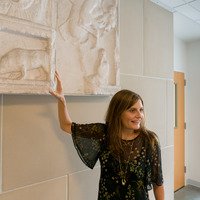
Greta Hawes
I am a scholar of Greek myth. My work examines ancient – and sometimes more recent – contexts for storytelling, the power of landscapes to shape and preserve stories, the Greeks’ assessment of mythic phenomena in their own culture, and the modes of interpretation to which these gave rise.
less
Related Authors
Richard P Martin
Stanford University
Verity Platt
Cornell University
Monica Berti
Universität Leipzig
Armando Marques-Guedes
UNL - New University of Lisbon
Stéphane Péquignot
Ecole Pratique des Hautes Etudes
Francesco Camia
Università degli Studi "La Sapienza" di Roma
Eser Kortanoğlu
Anadolu University
Kati (Katalin) Prajda
University of Vienna
Seth Bernard
University of Toronto
Ladislav Stančo
Charles University, Prague
InterestsView All (9)










Uploads
Books by Greta Hawes
In Pausanias in the World of Greek Myth, Greta Hawes uses Pausanias's text to illuminate the spatial dynamics of myth. She reveals the significance of local stories in an Empire connected by a shared literary repertoire, and the unifying power of a tradition made up paradoxically of narratives that took diverse, conflicting forms on the ground. We learn how storytelling and the physical infrastructures of the Greek mainland were intricately interwoven such that the decline or flourishing of the latter affected the archive of myth that Pausanias transmits.
This volume brings together leading scholars of Greek myth, literature, history and archaeology to examine the myriad intricate ways myth interacted with the physical and conceptual landscapes of antiquity. It highlights the plurality and pervasiveness of such interactions, and the crucial role of storytelling in Greek conceptions of space.
Papers by Greta Hawes
Abstract:
Anne Salmond has described Maguire’s work as giving visual expression to the pae, a liminal place of exchange and discussion in Māori culture. In A Taranaki Dialogue (2011), the currency of this exchange is overtly Socratic dialogue; the discussions of the agora and the symposium have been transplanted to the South Pacific. This chapter examines the ways in which dialectic wisdom plays out in this series of etchings, and the ways in which a viewer, compelled by Socrates’ questions to actively participate in the work, to engage her faculties of reason and imagination, animates these strangely inert landscapes.
A Taranaki Dialogue is Maguire’s darkest and least accessible work to date. Not only is the visual palate somber – the brooding Taranaki looks out over isolated figures – but the register includes none of the easy, whimsical humour which proved such a captivating facet of her work elsewhere. The entry point for the viewer remains, however, the distinctive triangulation of South Pacific, European, and ancient Greek elements. Where the colonized landscape of Taranaki dominates visually, the captions (‘Socrates asks “what is…”’) draw all of this into the ancient practice of dialectic philosophy.
As in the Platonic texts, Socrates’ questions provide a starting point for discussion. But whereas Plato then goes on to weave a series of answers and responses, it is up to the viewer of Maguire’s work to decide how this dialogue will progress. The visual juxtaposition of images, perspectives and ideas in Maguire’s etchings suggests something of the interactive nature of dialogue – the back and forth hammering of discussion, dispute, assertion, reflection and revision – but leaves its exact dynamics unmapped. The etchings are a kind of setting for staging a dialogue; they are a series of prompts which suggest any number of different trains of thought. This chapter will set out some possible responses to this work, concentrating on three images, What is Victory?, What is History? and What is Myth? It will move between potential responses to the questions these images provoke from the context of antiquity, and from that of contemporary New Zealand.
This essay examines the influence of allegoresis on the Greek mythic tradition in antiquity and the Middle Ages. It uses allegorical interpretations attached to the stories of Circe to illustrate more general themes regarding the process of allegorical reading as a mode of reception. It argues that the tradition of recounting Greek myths is inseparable from the interpretative and didactic traditions through which these stories were transmitted. Allegorical interpretations are not arbitrary impositions, but draw on existing modes of understanding myths and prompt, in turn, new habits of thinking about them. This radically revisionist method of conserving myths thus also plays a role in establishing the meanings felt to be “natural” to these stories. Likewise, the habitual nature of allegorical interpretation, which displays interest in parts of the mythic tradition to the exclusion of others, impacts habits of storytelling. Its proposals regarding the symbolic meaning of the Greek mythic tradition bring to prominence particular exemplary episodes and establish a new system of conceptual connections and oppositions between mythical characters.
Allegoresis is intimately connected with other elements of the mythic tradition. It was utilised as a form of literary criticism, offering commentary on the epic tradition in antiquity and on Ovid’s Metamorphoses from the twelfth century. Allegorical interpretations were also incorporated into several late antique and early medieval handbooks which transmitted stories in a mythographic format. The study of allegoresis, then, illustrates the ways in which interpretation creates an object of study through shifting interpretative habits: within the allegorical tradition, myths are, at different times, poetic artefacts indistinguishable from their most prominent literary expressions, and a canon of independent narratives.
In Pausanias in the World of Greek Myth, Greta Hawes uses Pausanias's text to illuminate the spatial dynamics of myth. She reveals the significance of local stories in an Empire connected by a shared literary repertoire, and the unifying power of a tradition made up paradoxically of narratives that took diverse, conflicting forms on the ground. We learn how storytelling and the physical infrastructures of the Greek mainland were intricately interwoven such that the decline or flourishing of the latter affected the archive of myth that Pausanias transmits.
This volume brings together leading scholars of Greek myth, literature, history and archaeology to examine the myriad intricate ways myth interacted with the physical and conceptual landscapes of antiquity. It highlights the plurality and pervasiveness of such interactions, and the crucial role of storytelling in Greek conceptions of space.
Abstract:
Anne Salmond has described Maguire’s work as giving visual expression to the pae, a liminal place of exchange and discussion in Māori culture. In A Taranaki Dialogue (2011), the currency of this exchange is overtly Socratic dialogue; the discussions of the agora and the symposium have been transplanted to the South Pacific. This chapter examines the ways in which dialectic wisdom plays out in this series of etchings, and the ways in which a viewer, compelled by Socrates’ questions to actively participate in the work, to engage her faculties of reason and imagination, animates these strangely inert landscapes.
A Taranaki Dialogue is Maguire’s darkest and least accessible work to date. Not only is the visual palate somber – the brooding Taranaki looks out over isolated figures – but the register includes none of the easy, whimsical humour which proved such a captivating facet of her work elsewhere. The entry point for the viewer remains, however, the distinctive triangulation of South Pacific, European, and ancient Greek elements. Where the colonized landscape of Taranaki dominates visually, the captions (‘Socrates asks “what is…”’) draw all of this into the ancient practice of dialectic philosophy.
As in the Platonic texts, Socrates’ questions provide a starting point for discussion. But whereas Plato then goes on to weave a series of answers and responses, it is up to the viewer of Maguire’s work to decide how this dialogue will progress. The visual juxtaposition of images, perspectives and ideas in Maguire’s etchings suggests something of the interactive nature of dialogue – the back and forth hammering of discussion, dispute, assertion, reflection and revision – but leaves its exact dynamics unmapped. The etchings are a kind of setting for staging a dialogue; they are a series of prompts which suggest any number of different trains of thought. This chapter will set out some possible responses to this work, concentrating on three images, What is Victory?, What is History? and What is Myth? It will move between potential responses to the questions these images provoke from the context of antiquity, and from that of contemporary New Zealand.
This essay examines the influence of allegoresis on the Greek mythic tradition in antiquity and the Middle Ages. It uses allegorical interpretations attached to the stories of Circe to illustrate more general themes regarding the process of allegorical reading as a mode of reception. It argues that the tradition of recounting Greek myths is inseparable from the interpretative and didactic traditions through which these stories were transmitted. Allegorical interpretations are not arbitrary impositions, but draw on existing modes of understanding myths and prompt, in turn, new habits of thinking about them. This radically revisionist method of conserving myths thus also plays a role in establishing the meanings felt to be “natural” to these stories. Likewise, the habitual nature of allegorical interpretation, which displays interest in parts of the mythic tradition to the exclusion of others, impacts habits of storytelling. Its proposals regarding the symbolic meaning of the Greek mythic tradition bring to prominence particular exemplary episodes and establish a new system of conceptual connections and oppositions between mythical characters.
Allegoresis is intimately connected with other elements of the mythic tradition. It was utilised as a form of literary criticism, offering commentary on the epic tradition in antiquity and on Ovid’s Metamorphoses from the twelfth century. Allegorical interpretations were also incorporated into several late antique and early medieval handbooks which transmitted stories in a mythographic format. The study of allegoresis, then, illustrates the ways in which interpretation creates an object of study through shifting interpretative habits: within the allegorical tradition, myths are, at different times, poetic artefacts indistinguishable from their most prominent literary expressions, and a canon of independent narratives.